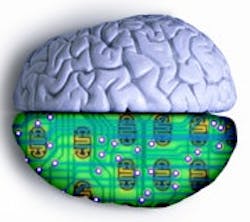Sensors Get Smart, Get Networked
Sensors always have been adjustable to one degree or another. But lately, they're becoming more programmable and flexible—just like every other device with processor-based data handling. Dip switches, potentiometers and text-based computer code are being replaced by software function blocks, point-and-click programming and the ability to save and propagate software profiles among different sensors.
"Ten years ago, the cost of embedding intelligence on a sensor was more I/O, but now you can pack a lot of intelligence onto a sensor's chip and have that one chip handle signal processing, bus communications and memory," says Matt Simms, Eaton's (www.eaton.com) product line manager for sensors.
The good news doesn't end there. Sensors that used to be networked via dedicated wiring to discrete I/O points and proprietary fieldbuses are freeing themselves from these often costly hardware and communication constraints. In fact, several sensor manufacturers recently developed the open, point-to-point IO-Link communication protocol and formed the IO-Link Consortium (www.io-link.com) to define non-competitive sensor intelligence that doesn't have to be on a proprietary fieldbus.
"These days, sensor programmability really means giving users the ability to set switch points via software rather than push buttons, and this allows them to better optimize their sensors for their own specific applications," says Gary Frigyes, Pepperl+Fuchs' (www.am.pepperl-fuchs.com) marketing manager for photoelectric sensors. "IO-Link takes a standard, three-wire sensor and makes its communications generic, so it doesn't need a custom chip or module. This allows intelligent sensors to read their diagnostic data back and lets users set switch limits, modes of operation, sensing ranges and other capabilities. This enables them to work their sensors into their traditional, normal control systems with 4-20 mA networking and dc inputs." IO-Link also lets users store reference marks, recipes and other parameters and then retrieve them as needed, such as when a sensor is damaged.
To gain the kinds of sensor intelligence that IO-Link can provide, Frigyes explains that users previously had to use ASIC and dedicated data-processing chips. "Fieldbuses can process digital data, but they don't have true electrical outputs," says Frigyes.
Henry Menke, Balluff's (www.balluff.com) marketing manager for object detection sensors, says sensors have been teachable for many years and able to exchange data via serial, USB or other network interfaces, but true programmability is a bi-direction phenomenon that involves sending data to a sensor that can read and analyze it and send back an appropriate response. "With bi-directionality, the user always gets back data that shows the sensor is tracking to the right value," says Menke. "Programmable sensors deliver constant feedback. Previously, users had to double-check these settings manually to make sure they hadn't changed. In addition, because large manufacturers are pushing for more traceability, all this feedback is useful because it helps them track and collect a lot more of the I/O points they need to trace their processes."
Likewise, Eric Henefield, Rockwell Automation's (www.rockwellautomation.com) marketing manager for photoelectric sensors, adds that today's programmable sensors permit automatic teaching from a distance or can even accept reprogramming every few hours. "A lot of our customers are asked to customize machines even more to the needs of individual users, and programmable sensors are adapting to help serve those applications," says Henefield. "For instance, users want to know if a machine is going to go down before it actually does, or they want a multitasking machine that can handle more diverse tasks, and sensors with more setups, parameters and diagnostics can help accomplish these goals."
The next steps probably will involve even more configuration on the fly, which already is seen in some color and vision sensors, believes Simms. "In the future, I think we'll see three or four machines set up to adapt and reconfigure themselves and then switch off production tasks," he adds. "The overall goal is still throughput."


